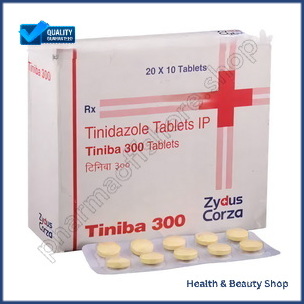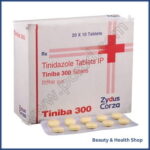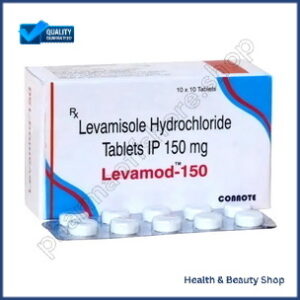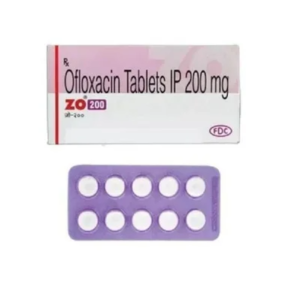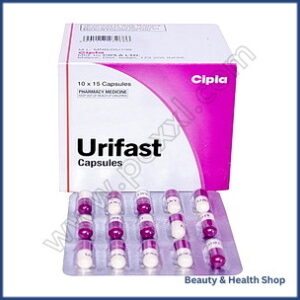ADDICTION
ALCOHOL DEPENDENCE
QUIT SMOKING
ALLERGY
ANTI FUNGAL
FUNGAL INFECTION
FUNGAL NAIL INFECTIONS
ANTI-REJECTION DRUGS
ANTI WORM
ANTIBIOTIC
BACTERIAL INFECTIONS
ARTHRITIS
GOUT
OSTEOARTHRITIS
RHEUMATOID ARTHRITIS
BLOOD
LOW PLATELET COUNT
THROMBOPHLEBITIS
VARICOSE VEINS
COLON
ANAL FISSURE
PILES
ULCERATIVE COLITIS
DIABETES CARE
DIABETES INSIPIDUS
DIABETES TYPE
DIABETIC FOOT ULCERS
GLUCOSE MONITOR
EYES/EAR CARE
DRY EYES
EYE CARE
EYE EXAMINATION
EYE INFECTION
EYE LASHES
EYE PAIN
GLAUCOMA
OCULAR HYPERTENSION
UVEITIS
FEVER CARE
MALARIA
RHEUMATIC FEVER
TYPHOID FEVER
GASTROINTESTINAL
ACIDITY
CONSTIPATION
CROHN'S DISEASE
DIARRHOEA
GALLBLADDER STONES
INTESTINAL ULCERS
IRRITABLE BOWEL SYNDROME
MOTION SICKNESS
NAUSEA
Tiniba (Tinidazole)
Tiniba 300 mg (Tinidazole)
| Active Ingredient (Generic Name): | Tinidazole |
|---|---|
| Indication: | Bacterial infections, Parasitic infections |
| Manufacturer | Zydus Cadila Pharma |
| Packaging: | 10 tablets in one strip |
From: $31.00
Tiniba is a medication prescribed for bacterial vaginosis, giardiasis, and amebiasis. It works by inhibiting bacterial protein production, disrupting ATP production, and halting new bacterial protein creation, leading to bacterial cell death. Available in oral tablet form, Tiniba effectively treats symptoms of bacterial vaginosis and giardiasis. However, it may cause gastrointestinal discomfort and allergic reactions. Understanding Tiniba’s uses, side effects, and interactions is essential for effectively combating infections and restoring balance in the body.
Main Points
- Tiniba (Tinidazole) is an antibiotic that hinders bacterial protein synthesis, disrupting ATP production and causing bacterial cell death.
- It is effective in treating bacterial vaginosis, giardiasis, and amebiasis, available in convenient oral tablet form.
- Common side effects include gastrointestinal discomfort, allergic reactions, and potentially life-threatening severe allergic reactions.
- Tiniba interacts with medications such as Warfarin, Phenytoin, Lithium, and Fosphenytoin, requiring caution with alcohol consumption.
- In the event of an overdose, immediate medical assistance is necessary, involving supportive care, fluids, oxygen therapy, and potential hospitalization.
How Tiniba Works in Body
When Tiniba is ingested, tinidazole’s antibiotic properties take effect by hindering the production of essential proteins for bacterial survival and replication. This occurs through the conversion of tinidazole into its active form, which then attaches to bacterial DNA, impeding their ability to reproduce. By targeting bacterial DNA, tinidazole halts the creation of new bacterial proteins, ultimately leading to the demise of bacterial cells.
The mechanism of action of tinidazole revolves around its interference with the bacterial cell’s energy generation capacity. It achieves this by inhibiting the enzyme crucial for the electron transport chain, necessary for ATP production. In the absence of ATP, bacterial cells lose their functionality and eventually perish. As tinidazole combats the bacterial infection, the body’s immune system can then eliminate the deceased bacterial cells, facilitating the healing process. Through its antibiotic properties, Tiniba aids the body in restoring its natural equilibrium and recovering from infection.
Uses and Treatment Options
Explore the uses of Tiniba for treating bacterial vaginosis, giardiasis infections, and amebiasis disease. Tiniba is effective in combatting these conditions in women.
Bacterial Vaginosis Treatment
Tinidazole is an antibacterial and antiprotozoal medication commonly used to treat bacterial vaginosis, an infection resulting from an imbalance of vaginal bacteria. Tinidazole’s benefits in managing bacterial vaginosis include:
- Alleviating symptoms like abnormal vaginal discharge, itching, and burning sensations.
- Restoring the natural balance of vaginal flora by targeting the causative bacteria.
- Reducing the risk of recurrent bacterial vaginosis based on studies.
- Offering a convenient treatment option in oral tablet form for ease of use.
Giardiasis Infection Management
Managing giardiasis, a parasitic infection caused by Giardia lamblia, involves effective treatment, with tinidazole being a reliable option. Understanding available treatment choices is crucial during giardiasis infection management. Tinidazole is a popular treatment among healthcare professionals due to its high efficacy and low side-effect profile.
| Symptom | Tinidazole Treatment Outcome |
|---|---|
| Diarrhea | Symptoms resolve rapidly within 3-5 days |
| Abdominal cramps | Severity and frequency significantly reduced |
| Weight loss | Appetite restored and weight gained within 1-2 weeks |
| Fatigue | Energy levels improved and lethargy reduced |
| Vomiting | Complete cessation of vomiting episodes |
Early intervention with tinidazole is essential in preventing complications and lowering transmission risks. Understanding the benefits of tinidazole treatment enables informed decision-making for care and initiates the path to recovery.
Amebiasis Disease Control
When managing amebiasis, a parasitic infection caused by Entamoeba histolytica, consider alternative treatments like metronidazole or paromomycin. Understanding the nuances of amebiasis disease control is crucial for healthcare professionals. While Tinidazole (Tiniba) is a common prescription for amebiasis, it’s not the sole option available.
Treatment strategies for amebiasis include antiparasitic medications like metronidazole, tinidazole, and paromomycin. Providing supportive care for symptoms such as diarrhea, abdominal pain, and fever is essential. Fluid and electrolyte replacement is crucial for maintaining hydration in patients with amebiasis. Educating patients on proper hygiene practices can also help prevent the spread of the disease.
Common Side Effects and Risks
When taking Tiniba (Tinidazole), be aware of potential side effects like gastrointestinal discomfort such as nausea, vomiting, or diarrhea. These effects are typically manageable. Allergic reactions are a risk, and it is important to monitor your body’s response closely.
Gastrointestinal Side Effects
Gastrointestinal upset is a common issue for individuals using Tiniba, with around 10-20% of users reporting mild to moderate stomach discomfort, nausea, and diarrhea. These symptoms may occur, especially at the beginning of treatment. Over time, your body may adjust, and the symptoms could decrease. It’s important to be aware of these potential gastrointestinal side effects to take proper precautions. Some common side effects of Tiniba on the gastrointestinal system include mild to moderate nausea, diarrhea, abdominal pain or cramps, and vomiting in severe cases. Staying hydrated by consuming plenty of fluids and following a balanced diet can help lessen the severity of these side effects.
Allergic Reactions Possible
Allergic reactions may occur while taking Tiniba, presenting symptoms ranging from mild to severe. Recognizing these potential reactions is important to promptly seek medical attention if needed.
Symptoms of an allergic reaction include:
- Hives: Red, itchy, swollen patches on the skin
- Itching: Mild to severe skin irritation
- Swelling: Face, lips, tongue, or throat swelling
In rare instances, Tiniba can trigger a severe allergic reaction, leading to life-threatening conditions. If any of the following symptoms occur, seek immediate medical help:
- Difficulty breathing
- Swelling of the face, lips, tongue, or throat
- Dizziness or fainting
If an allergic reaction is suspected, discontinue Tiniba and consult a healthcare professional for guidance on managing symptoms and ensuring safety.
Drug Interactions and Warnings
When taking Tiniba (Tinidazole), it’s crucial to disclose all your current medications, supplements, and vitamins to your doctor. This helps prevent potential interactions that could compromise the effectiveness of Tiniba or increase the risk of adverse effects. Some medications that may interact with Tiniba include Warfarin, Phenytoin, Lithium, and Fosphenytoin. Warfarin may heighten the risk of bleeding, while Tiniba could reduce the efficacy of phenytoin, leading to inadequate seizure control. Additionally, Tiniba may elevate lithium toxicity and increase the risk of fosphenytoin toxicity, resulting in adverse reactions. It’s essential to discuss your medication regimen with your doctor before starting Tiniba treatment to avoid complications. Also, be cautious with alcohol consumption, as it may exacerbate Tiniba’s side effects.
Dosage and Administration Guide
Take Tiniba (Tinidazole) orally with food as directed by your healthcare provider or as indicated on the medication label. The dosage of Tiniba varies depending on the type of infection being treated. For bacterial vaginosis, the typical dose is 2 grams taken as a single dose. For trichomoniasis, the recommended dosage is 2 grams once daily for 2-3 days. For giardiasis, the usual dose is 2 grams once daily for 3 days. For amoebiasis, the standard dose is 2 grams once daily for 3-5 days. Swallow the tablets whole with a full glass of water; do not chew, crush, or break them. If swallowing is difficult, discuss alternative administration methods with your healthcare provider. Take Tiniba at the same time each day to maintain a consistent level of the medication in your body. If you miss a dose, take it as soon as you remember, but do not double up on doses. Follow your healthcare provider’s instructions carefully and complete the full course of treatment to ensure the infection is effectively cleared.
Overdose Symptoms and Treatment
If you accidentally take more Tiniba (Tinidazole) than prescribed, overdose symptoms may include nausea, vomiting, abdominal pain, dizziness, headache, and in rare cases, seizures. Cardiovascular issues like rapid heartbeat and low blood pressure can also occur, with severe cases potentially leading to cardiac arrest. Respiratory problems such as shortness of breath and coughing may manifest as well.
In case of a Tiniba overdose, seek immediate medical help. Treatment usually involves supportive care like fluids and oxygen therapy to manage symptoms and prevent complications. Hospitalization may be necessary for severe cases to monitor and address life-threatening symptoms. Contact your local emergency services or poison control center if an overdose is suspected.
History and Brand Names
Tiniba, a medication with a long history, was initially launched as Fasigyn in the 1970s by Pfizer. Over the years, it has been marketed under various brand names worldwide. In some countries, it is known as Simplotan, while in others, it goes by Tindal or Tinidazole. In the United States, it is available as Tindamax. Tiniba has evolved to treat a wide range of infections and parasitic diseases. Understanding its origins and the different brand names it carries globally can help in recognizing its versatility and effectiveness in managing various health conditions.
Frequently Asked Questions
Can I Take Tiniba With Other Medications for Giardiasis?
When treating giardiasis, it is important to inform your doctor about all medications you are taking, including supplements and vitamins. Certain drugs, such as metronidazole, can interact with others, potentially leading to adverse reactions. It is advisable to consult your doctor before combining medications to ensure safe and effective treatment. Your doctor will assist in determining the most suitable treatment plan and minimizing the risk of interactions.
Is Tiniba Safe for Pregnant or Breastfeeding Women?
When considering treatment for giardiasis during pregnancy or while breastfeeding, caution is advised due to potential risks to the developing fetus or baby. It is recommended to consult a healthcare provider to discuss the safety and effectiveness of treatment options. Prioritize the health of both yourself and your baby, and refrain from starting any medication without medical guidance.
Can I Drink Alcohol While Taking Tiniba Medication?
While taking medication, it is advisable to avoid or limit alcohol consumption. Alcohol can potentially interact with the medication, impacting its efficacy and increasing the likelihood of negative reactions. It is important to seek advice from your healthcare provider or pharmacist regarding the appropriate amount of alcohol, if any, that is safe to consume based on your specific medication and health condition.
How Long Does It Take to See Results With Tiniba Treatment?
The time it takes to see results with Tiniba treatment varies depending on the specific condition being treated and individual factors. Generally, improvements for parasitic infections may be noticed within 3-7 days, while symptoms of bacterial vaginosis can subside within 7-10 days. It is important to complete the full treatment course as prescribed to ensure the infection clears completely.
Can I Crush or Split Tiniba Tablets for Easier Consumption?
When modifying your medication, it is important to proceed with caution. Crushing or splitting Tiniba tablets may compromise their effectiveness and lead to inconsistent dosing. It is not recommended to crush or split Tiniba tablets, as this can disrupt the controlled-release mechanism intended to provide a steady dose. It is advisable to consult your healthcare provider or pharmacist for alternative options, such as switching to a liquid formulation or exploring other safe and effective administration methods.
Conclusion
It is essential to adhere to the prescribed dosage and administration instructions when taking Tiniba, a medication used to treat various infections. Be mindful of potential drug interactions and warnings. Seek immediate medical attention if you experience severe adverse reactions or symptoms of overdose.

